
Under the Whyte notation for the classification of steam locomotives, 4-6-2 represents the wheel arrangement of four leading wheels on two axles, six powered and coupled driving wheels on three axles and two trailing wheels on one axle. The 4-6-2 locomotive became almost globally known as a Pacific type after a New Zealand locomotive that was shipped across the Pacific Ocean.

Under the Whyte notation for the classification of steam locomotives, 4-8-2 represents the wheel arrangement of four leading wheels, eight powered and coupled driving wheels and two trailing wheels. This type of steam locomotive is commonly known as the Mountain type, but the New York Central Railroad called their 4-8-2s the Mohawk type.

Under the Whyte notation for the classification of steam locomotives, 4-8-4 represents the wheel arrangement of four leading wheels on two axles, eight powered and coupled driving wheels on four axles and four trailing wheels on two axles. The type was first used by the Northern Pacific Railway, and initially named the Northern Pacific, but railfans and railroad employees have shortened the name since its introduction. It is most-commonly known as a Northern.
Under the Whyte notation for the classification of steam locomotives, 2-10-0 represents the wheel arrangement of two leading wheels on one axle, ten powered and coupled driving wheels on five axles, and no trailing wheels. This arrangement was often named Decapod, especially in the United States, although this name was sometimes applied to locomotives of 0-10-0 "Ten-Coupled" arrangement, particularly in the United Kingdom. Notable German locomotives of this type include the war locomotives of Class 52.
Under the Whyte notation for the classification of steam locomotives, 2-10-2 represents the wheel arrangement of two leading wheels, ten powered and coupled driving wheels, and two trailing wheels. In the United States and elsewhere the 2-10-2 is known as the Santa Fe type, after the Atchison, Topeka and Santa Fe Railway that first used the type in 1903.
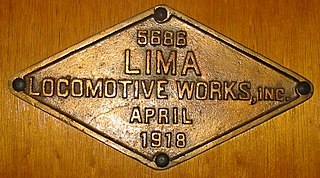
Lima Locomotive Works was an American firm that manufactured railroad locomotives from the 1870s through the 1950s. The company took the most distinctive part of its name from its main shop's location in Lima, Ohio. The shops were located between the Erie Railroad main line, the Baltimore & Ohio's Cincinnati-Toledo main line and the Nickel Plate Road main line and shops.

Under the Whyte notation for the classification of steam locomotives, 4-2-0 represents the wheel arrangement of four leading wheels on two axles, two powered driving wheels on one axle and no trailing wheels. This type of locomotive is often called a Jervis type, the name of the original designer.
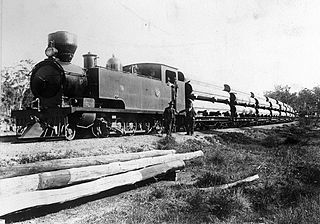
Under the Whyte notation, a 2-8-4 is a steam locomotive that has two unpowered leading wheels, followed by eight coupled and powered driving wheels, and four trailing wheels. This locomotive type is most often referred to as a Berkshire, though the Chesapeake and Ohio Railway used the name Kanawha for their 2-8-4s. In Europe, this wheel arrangement was mostly seen in mainline passenger express locomotives and, in certain countries, in tank locomotives.

In the Whyte notation, a 6-2-0 is a railroad steam locomotive that has an unpowered three-axle leading truck followed by a single powered driving axle. This wheel arrangement is associated with the Crampton locomotive type, and in the USA the single class were sometimes referred to as Cramptons.
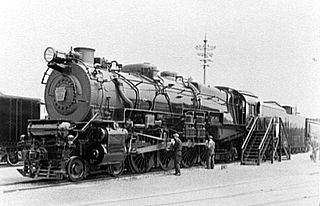
The M1 was a class of steam locomotive of the Pennsylvania Railroad (PRR). It was a class of heavy mixed-traffic locomotives of the 4-8-2 "Mountain" arrangement, which uses four pairs of driving wheels with a four-wheel guiding truck in front for stability at speed and a two-wheel trailing truck to support the large firebox needed for sustained power. Although built for both passenger and freight work, they spent most of their service lives hauling heavy high-speed freight trains. Many PRR men counted the M1 class locomotives as the best steam locomotives the railroad ever owned.
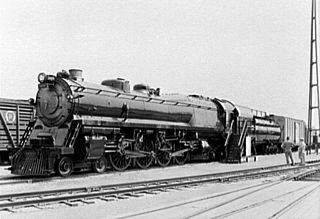
A 4-4-4-4 steam locomotive, in the Whyte notation for describing locomotive wheel arrangements, has a four-wheel leading truck, two sets of four driving wheels, and a four-wheel trailing truck. While it would be possible to make an articulated locomotive of this arrangement, the only 4-4-4-4s ever built were duplex locomotives—with two sets of cylinders driving two sets of driven wheels in one rigid frame, essentially a 4-8-4 with divided drive.

The Pennsylvania Railroad's S2 class was a steam turbine locomotive designed and built in a collaborative effort by Baldwin Locomotive Works and Westinghouse Electric & Manufacturing Company, as an attempt to prolong the dominance of the steam locomotive by adapting technology that had been widely accepted in the marine industry. One was built, #6200, delivered in September 1944. The S2 was the sole example of the 6-8-6 wheel arrangement in the Whyte notation, with a six-wheel leading truck keeping the locomotive stable at speed, eight powered and coupled driving wheels, and a six-wheel trailing truck supporting the large firebox. The S2 used a direct-drive steam turbine provided by the Westinghouse Electric & Manufacturing Company, geared to the center pair of axles with the outer two axles connected by side rods; the fixed gear ratio was 18.5:1. Such design was to prevent energy loss and S2 achieved a mechanical efficiency of 97% which means only 3% of steam energy was lost within the propulsion equipment. The disadvantage of a direct-drive steam turbine was that the turbine could not operate at optimal speeds over the locomotive's entire speed range. The S2 was the largest, heaviest and fastest direct-drive turbine locomotive design ever built.

Under the Whyte notation for the classification of steam locomotives, 4-4-4 represents the wheel arrangement of four leading wheels on two axles, four powered and coupled driving wheels on two axles, and four trailing wheels on two axles. In the United States, this arrangement was named the Reading type, since the Philadelphia and Reading Railroad was the first to use it. In Canada, this type is known as the Jubilee.

The PRR S1 class steam locomotive was a single experimental duplex locomotive of the Pennsylvania Railroad. It was designed to demonstrate the advantages of duplex drives espoused by Baldwin Chief Engineer Ralph P. Johnson. It was the longest and heaviest rigid frame reciprocating steam locomotive that was ever built. The streamlined Art Deco styled shell of the locomotive was designed by Raymond Loewy.
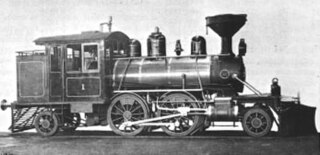
Under the Whyte notation for the classification of steam locomotives, 2-4-2 represents the wheel arrangement of two leading wheels on one axle, four powered and coupled driving wheels on two axles and two trailing wheels on one axle. The type is sometimes named Columbia after a Baldwin 2-4-2 locomotive was showcased at the 1893 World's Columbian Exposition held at Chicago, Illinois.
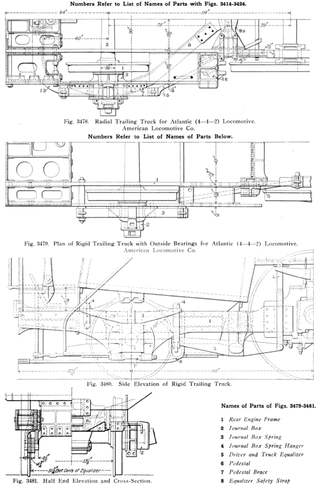
On a steam locomotive, a trailing wheel or trailing axle is generally an unpowered wheel or axle (wheelset) located behind the driving wheels. The axle of the trailing wheels is usually located in a trailing truck. On some large locomotives, a booster engine was mounted on the trailing truck to provide extra tractive effort when starting a heavy train and at low speeds on gradients.

Under the Whyte notation for the classification of steam locomotives, 2-6-0+0-6-2 represents the wheel arrangement of an articulated locomotive with two separate swivelling engine units, arranged back to back with the boiler and cab suspended between them. Each engine unit has two leading wheels in a leading truck, six powered and coupled driving wheels on three axles and no trailing wheels.

Under the Whyte notation for the classification of steam locomotives by wheel arrangement, a 2-8-2+2-8-2 is an articulated locomotive using a pair of 2-8-2 power units back to back, with the boiler and cab suspended between them. The 2-8-2 wheel arrangement has a single pair of leading wheels in a leading truck, followed by four coupled pairs of driving wheels and a pair of trailing wheels in a trailing truck. Since the 2-8-2 type was known as Mikado, the corresponding Garratt and Modified Fairlie types were usually known as Double Mikado.

St. Louis–San Francisco 4018 is a class USRA Light 2-8-2 "Mikado" steam locomotive which operated for three decades hauling freight between Bessemer and Birmingham, Alabama, on the St. Louis–San Francisco Railway. It went on display at the Alabama State Fairgrounds in 1952 and is one of only a few locomotives of its type that survive.
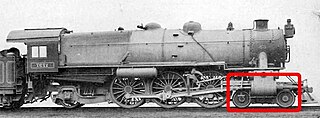
The leading wheel or leading axle or pilot wheel of a steam locomotive is an unpowered wheel or axle located in front of the driving wheels. The axle or axles of the leading wheels are normally located on a leading truck. Leading wheels are used to help the locomotive negotiate curves and to support the front portion of the boiler.























